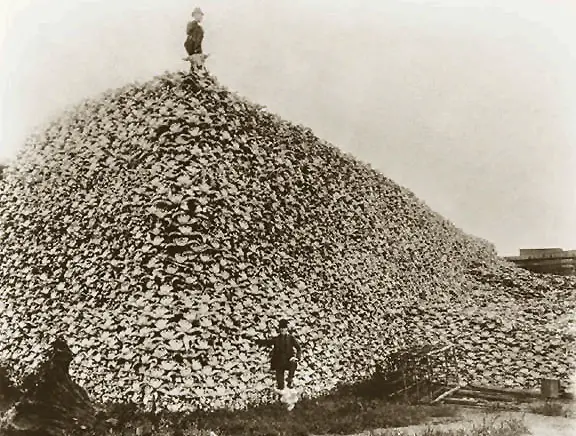|
How Much Powder Should I Use in My Inline Muzzleloader? Jack
O'Connor's quivering blobs of protoplasm (human beings) get all sorts of whacky
ideas that don't easily go away. We like to think there is such a thing as knockdown
power, but physics tells us that if we were to actually knock down an animal
our guns would knock us down with about the same force. It is ridiculous, but
magnumitis can be a rough disease to shake. The standard U.S. Military round
from 1873-1892 (it served into the 20th Century as a substitute standard), the
.45-70 Government, was responsible in large measure for eradication of both the
American Bison and the grizzly bear from the United States in a few short
years. It fired a 500 grain, .458 diameter bullet at MV's between 1400-1500 fps for long range use
or a lighter cavalry load ("managed recoil" in modern terms) using a 405
grain, .458 diameter bullet at 1305 fps. The
.45-70 has always been tremendously effective on game. Buffalo Bill's favorite bison
gun was named Lucretia Borgia. It was a .48 caliber Springfield Trapdoor, the
gun that William Cody killed 4,250 buffalo with in one year and 4,862 buffalo
in eighteen months for the Union Pacific railroad, along with deer and
antelope. Cody claimed some 40,000 buffalo in his career, not all of them with
Lucretia Borgia, but most of them were. Lucretia Borgia threw a 470 grain
conical pushed by 70 grains of black powder.  In the
late 1990's, Ian McMurchy conducted a series of hot and cold tests with a variety
of inline .50 caliber muzzleloaders, firing 100 grains by volume of Pyrodex RS
pushing a saboted 300 grain Hornady XTP bullet. With 209 shotshell primer
ignition, 72 degrees F. muzzle velocities averaged 1610 fps, while his -15
degrees F. velocities averaged 1567 fps. Other tests were conducted using 300
grain saboted bullets and 100 grains by volume of different propellants. 100
grains of Goex FFG averaged 1468 fps, Goex Clear Shot averaged 1404 fps, ARCO
averaged 1384 fps, and Quick Shots averaged 1233 fps. The highest velocity
recorded in this series of tests was 1594 fps by 100 grains of volume of
Pyrodex P. A 100
grain volumetric charge has always been considered a full-powered hunting load
out of inlines ever since the 1980's launched the renewed interest in
muzzleloading hunting. With black powder and 300 grain sabots, it has
historically been in the 1500 fps area. This load has taken a tremendous amount
of game in the last twenty years. Today, I
am often asked, “How much powder”? When my answer is 80 grains or so by volume
of Blackhorn 209, more then a few people seem puzzled. Don't we need magnum
loads to take a deer at 100 yards? Well, not hardly, and we never have. There
has yet to be any substitute for good shot placement. What of this 80 grain
charge of Blackhorn 209, anyway? An 80
grain volumetric charge of Blackhorn 209 pushes a 300 grain saboted bullet to
around 1650 fps muzzle velocity, contingent on specific muzzleloader and
precise bullet/sabot combination. That's 10% faster than a 100 grain black
powder charge of Goex FFG and faster than 100 grains of Pyrodex RS or Pyrodex
P. Unless you think that the countless millions of deer, elk, and black bear
that have fallen to 100 grains of black powder or Pyrodex over the years is
just coincidence, 80 grains by volume of Blackhorn 209 is more than adequate
for any of these to 150 yards or so. If your muzzleloader kicks too hard, well,
you're the one who loaded it. You can make it kick you if you really want to.
It will not make anything deader inside 150 yards, but if you look hard enough
for recoil, I suspect you will be able to find it. One
hundred grains of Blackhorn 209 is an ideal load for most hunting ranges and
applications. That ups your muzzle velocity to 1850 – 1890 fps with a 300 grain
sabot. Most deer, regardless of firearm, are taken inside 100 yards, inside 50
yards in many areas. Ironically, I hear a few folks carping about propellant
costs. If you want to increase your powder costs by 50%, that is easy. Just up
your powder charge from 80 to 120 grains. It is almost like burning your money.
In most cases, it is exactly like burning your money and you are the one who
decided to burn it. Once we understand that 80 grains of Blackhorn 209 by
volume is not just equal, but ballistically superior, to 100 grains of black
powder, Pyrodex and Pyrodex pellets we might not be quite as quick to burn it
without purpose. A smooth, comfortable, repeatable, accurate load wins every time. It is one of the obvious benefits versus the “take two pellets and call me in the morning” type of thinking. That is no way to work up a load. Loose powder allows you to dial in your muzzleloader to the velocity, accuracy, and shooting comfort levels you prefer. That's a huge advantage! |